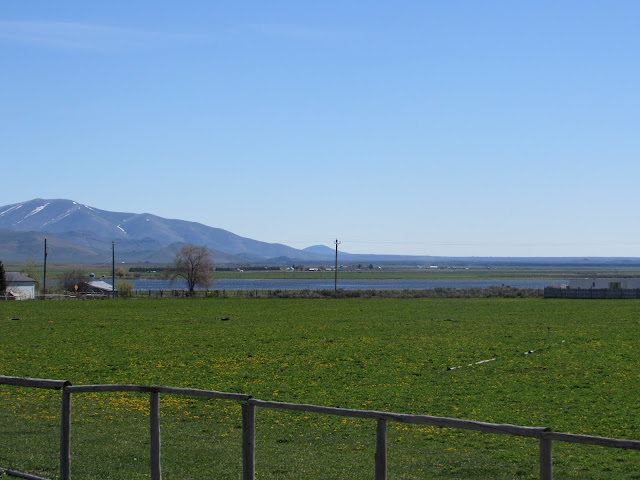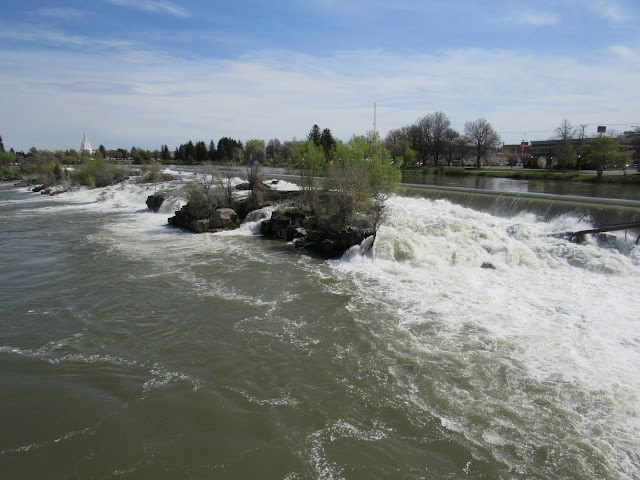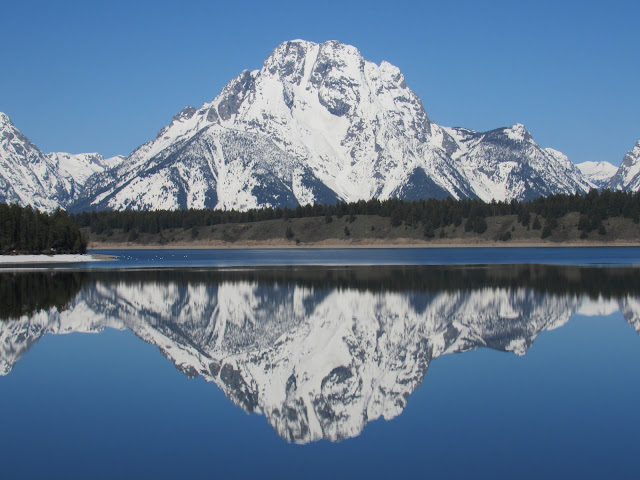Well here we are back in the US for another thrilling
adventure over the next 4 months. Since leaving in September 16 the RV has been
in storage at a gated park in Bakersfield, California and costing just
US$37/month, shame the boat’s not as cheap. Our flight over with Virgin was great, virtually had the whole rear end of the plane to ourselves. We both set up a bed each across 3 seats so had a very pleasant rest watching movies and eating the copious amounts of food provided, hope it’s the same going home. We breezed through customs and arrived at Avis for our rental 1 hour early, dodged our way through the LA traffic readjusting to driving on the right side of the road as we went. The trip to Bakersfield is only a couple of hours so we were at the park before lunch.
 |
| A good investment for $50 |
Borrowing a ladder from the guy we purchased the cover from
last year I climbed up onto the roof of the RV and removed the cover, 7 months
left in storage and now just as we’d left it, albeit 1 deflated tire on the
left hand rear set, it was better than we had expected thankfully. After hooking up both batteries and with crossed fingers the
trusty Ford V8 started first go, turned the propane (gas) on and fired up the
fridge, all was good to go, YEE HAA!!!
 |
| Pealing back the shell to reveal all is good below |
We parked up in the overnight section of the park and hooked
into the power, filled the water tank, checked all systems were operating
properly and then unpacked. A short drive down town to drop of the rental and
then back for a well-earned snooze, provisions could wait till tomorrow. Rather than hang around at the park we decided to get moving
so we organised 4 new rear tires with the 2 inside rears put on the front,
virtually new all-round now. A trip to Walmart for provisions, another trip to
a mall for Jen’s new sunglasses and away we went.
 |
| Lake Isabella is a playground for strutting boating enthusiasts, showing off their rooster tails |
First stop was Lake Isabella, east of Bakersfield and south
of the Sierra Nevada Mountains, we skirted north of it last year on our way to
the Sequoia NP. A lovely overnight stop away from the city noise. It’s good to
see some familiar faces as we observed a squirrel family going about its daily
chores while we sat and had lunch.
 |
| A cottontail rabbit hiding amongst the boulders |
 |
| A busy squirrel enjoying some of our scraps, a good change from his winter stores of nuts |
We’ve arrived a month earlier this year so it’s still spring,
the air is cool with blue skies and since the west had a lot of rain and snow
this winter plenty of water runoff in the streams, also a greenish tinge to the
landscape, with plenty of wild flowers in bloom. Not bad for a desert!!
 |
| A flowering Joshua Tree |
 |
| A very pretty desert cactus in bloom |
After a night at Lone Pine in the Alabama Hills east of Mt
Whitney we headed NE off the highway and climbed up to 10,000 feet into the
snow to a very isolated park where the oldest trees in the world can be found.
The bristlecone pine trees only survive in this one location where the
conditions are suitable and little human influences affect their very slow
growth. The forest was discovered by Edmund Shulman in 1953 and here he determined the extraordinary age of several specimens and was amazed at how close the growth rings were being only quite a small tree.
 |
| A very popular pastime with many Americans, not sure if this guy is very comfortable however |
 |
| A very chilly entry to the Bristlecone Pine Tree Forest at 10,000ft |
 |
| A bristlecone pine tree, some are more than 4,000 years old |
 |
| Because these trees grow so slowly they become very gnarly over time and very beautiful, the strong pine smell in this area is amazing |
 |
| Looking back from the forest on White Mountains (10,000ft) to the distant Sierra Nevada Mountains (14,000ft), a huge glacier formed valley separates the 2 mountain ranges. |
Into Nevada and again like last year it did not excite us,
it’s a poor desert and has very little of interest, mostly mining operations,
long straight roads and not much else. We were happy crossing into Idaho which
presented us with greenery and a very active farming community.
 |
| A road less travelled, looking back from Nevada to California |
 |
| A desert dweller common in the Nevada Deserts |
Southern Idaho is a huge agricultural hub fed by the Snake
River which originates in NW Wyoming and travels over 1,000 mile connecting to
the Columbia River in Oregon before emptying into the Pacific Ocean. This year
especially has seen huge snowfalls and rain, making the river swollen and
according to locals the most spectacular for years. All along the river are
waterfalls which are put to good use by providing hydro power to the local communities
and other cities across the country.
 |
| Idaho is famous for it's potatoes grown en-masse and with the fertility of this area it's not surprising |
 |
| 1800's RV for the pilgrim's as they crossed the country, not so luxurious in those days |
A major event happened in this region about 10,000 years
ago. A huge inland lake covering 600,000 square mile with an average depth of
100ft broke its natural dam wall and sent a 370ft high wall of water travelling
at 70 mph down the adjoining Snake River Canyon, scouring out the base and
creating the falls along its length. The most spectacular of which is the
Shoshone Falls at Twin Falls. The event was known as the Bonneville Flood and
the remains of the Bonneville Lake is the vast salt desert of Utah home to Salt
Lake City.
 |
| The Shoshone Falls at Twin Falls Idaho on the Snake River, last year it was just a trickle, this year quite spectacular |
To the north of Twin Falls is an area of recent volcanic
activity (geologically speaking) which has been active from 20 million till 1,500
years ago caused by a hot spot under the Earth’s Crust creating what is called
the Craters of The Moon landscape, with massive lava flows covering 750,000
acres. This site is part of the larger Snake River Basin where all this
activity has occurred and covers the whole Southern section of Idaho, any rain
and snow fall leaches through the lava and travels up to 100 mile underground
spilling into the Snake River through springs in the canyon’s walls.
 |
| Part of a massive lava flow which occurred just 2,000 years ago |
 |
| Cinder Cone fragments parts of the cone wall blown about 1 mile from the cone at the time it erupted |
 |
| Question: What do you do with an extinct volcano. Answer: Turn it into a digital hotspot |
Further up river is the lovely city of Idaho Falls,
spectacular for many reasons. Firstly its falls and secondly because it
provides a free tourist park right alongside the river, with complimentary dump
facilities. One night is the limit but at this time of year before the tourist
season no one seemed bothered with checking. It was an ideal place for us to provision,
laundry and purchase our hiking boots, waterproof leather US style but
apparently put together in China. What isn’t these days. Very comfy and much
better for walking through snow than the canyon busting black double bunger
thongs. The boot salesman was more than surprised when informed we had walked
through the snow at Bristlecone Forest in our THONGS!! Americans call them G
strings!!
 |
| Idaho Falls on the Snake River, these falls are located in the city centre and although not high they run along the river for nearly 1 mile |
 |
| A beautiful Siberian Husky with the most insane blue eyes and a natural aggressive look but very docile |
 |
| Our camp at Idaho Falls on the banks of the Snake River |
 |
| This Canadian Geese family were our neighbours at the campground in Idaho Falls |
Our first major park for the year was Grand Teton NP in
Wyoming only 100 mile from Idaho Falls (elevation 4,700ft) but a world away
with regards climate, landscape, scenery, animals, etc, etc. To get to Jackson
Hole, the southern entrance we had to traverse the Teton Pass at 8, 500ft and
totally snow covered, the road opened and maintained by snow ploughs. The town
of Jackson was once the most expensive real estate in the US as Wyoming has no
income tax thus bringing loads of rich New Yorker’s claiming residency and as a
result all the workers have to live on the western side of the Teton Pass in
Idaho where real estate is much cheaper, therefore needing the road open all
year round.
 |
| This monument is made from Elk antlers which the animals shed every year before winter, growing another set before the next breeding season |
 |
| The Teton Mountains early in the morning, temps were down to 0 degrees in the mornings |
 |
| A close encounter with a bull Bison we named Bill, but somehow it doesn't have the same ring as a Buffalo Bill |
The photos can tell the story of this unique area as words
cannot describe the scale and beauty, the mountain range is simply stunning and
was created by a 40 mile long fault along the eastern edge creating uplift
while the crust to the east slides under in a westerly motion. The rock at the
peaks are some of the oldest on the planet dating back 2 billion years. Mount
Moran’s peak is sandstone and was once a beach, unfortunately the snow covers
it at this time of year so the coloured layers can’t be seen.
 |
An early settlers house with stunning mountain views, Grand Teton is the highest peak, they were given 160 acres free providing they stayed 5 years, raised cattle or sheep and grew crops, not many survived in the 1800's, not sure what the Indian's thought of this arrangement.
|
 |
| Stunning views on Jackson Lake |
We were a little disappointed with the numbers of “wild “
animals as most of those that we saw appeared to be grazing in enclosures created
possibly for their protection from vehicles and human intrusion, many were very
skittish when we approached and most kept a long distance away. The female elk
and bison are pregnant at present and due to drop late May or early June so this could also
explain their behaviour. The bison (wrongly called buffalo) are supposed to be
uncontainable but the ones we saw were just like cattle and surprisingly few in
number. We have been informed by locals that bison may appear docile but can quickly become very aggressive and are in fact responsible for most deaths and injuries to humans in the parks.
 |
| A bull elk we named Eric playing chicken with the traffic, big aren't they. |
 |
Eric posing for us, he decided to stay and keep us company for the night, but more likely keeping between us and the herd of his females in a paddock below. Note the new antlers which grow an inch per day.
|
 |
| Wild as can be, a wolf we spotted with a fresh kill, a game raven along side is waiting its turn |
The Southern access to the famous Yellowstone NP is at the
northern end of Teton NP and opens on May 12th so we are hanging to
enter as soon as it opens. We are stopped at the closed off entry awaiting
permission to pass so will leave this blog here and hope you enjoy the photos.
 |
| An American Bluebird |
 |
| An American Robin |
 |
| A Yellow Breasted Chat |
 |
| An American Magpie, these have a black tail about a foot long and are very aggressive towards the squirrels at nesting time |
 |
| A Sandhill Crane |
BYE FOR NOW
Beers and Cheers with our favourite Coors Boutique a real classic
J & J






































No comments:
Post a Comment